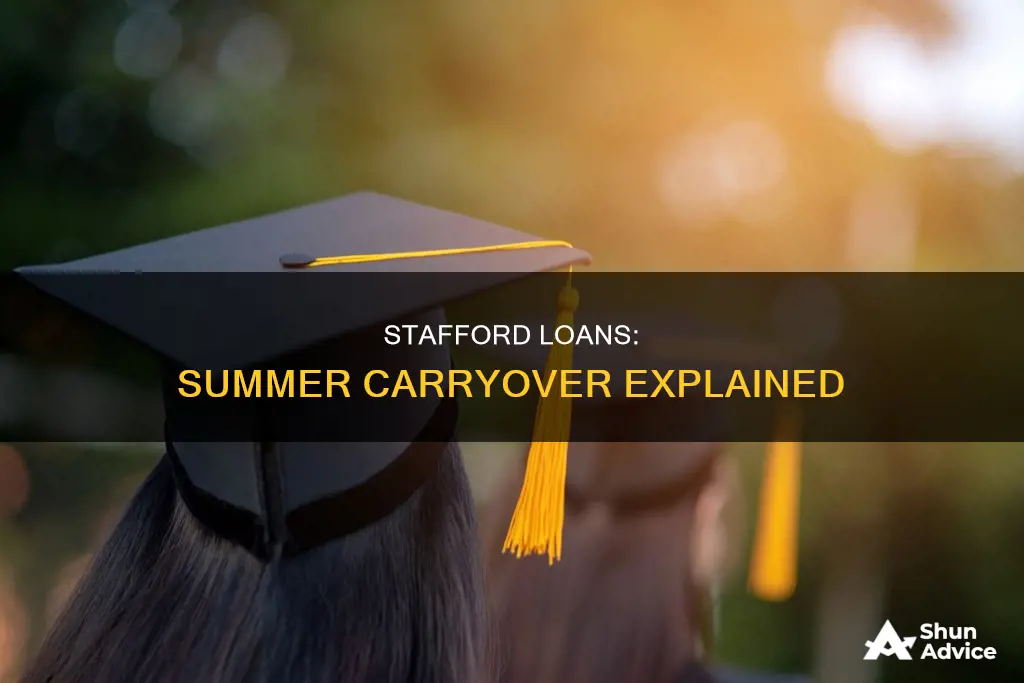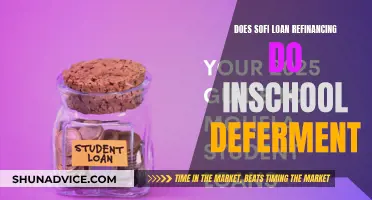
The Federal Stafford Loan, also known as the Federal Direct Loan, is the largest and most popular student loan program. Stafford loans are among the easiest to obtain because the government does not assess your credit or ability to repay them. There are two types of Stafford loans: subsidized and unsubsidized. Subsidized loans are offered to undergrads who demonstrate financial need, while unsubsidized loans are available to undergraduate, graduate, and professional students who are enrolled at least half-time. So, does a Stafford loan carry into the summer? The answer is yes, as long as the student is still enrolled in school. The federal government pays the interest on subsidized loans during the in-school and grace periods, as well as other deferment periods, such as during an economic hardship deferment.
| Characteristics | Values |
|---|---|
| Interest rate | Fixed, but varies based on disbursement date |
| Origination fee | 1.057% for loans disbursed on or after 10/1/20 and before 10/1/25 |
| Repayment period | 10 years (standard), with options for longer or alternate repayment plans |
| Grace period | 6 months before repayment begins |
| Maximum eligibility period | 150% of the published length of the degree program |
| Borrowing limits | Subsidized: $5,500 per year or $23,000 total; Unsubsidized: $20,500 annual for grad school, $138,500 lifetime, $40,500 annual for medical school, $224,000 lifetime |
| Eligibility | Demonstrated financial need for subsidized loans; no financial need requirement for unsubsidized loans |
| Loan forgiveness | Teacher Loan Forgiveness, Public Service Loan Forgiveness |

Stafford loan types
Stafford loans are federal student loans made by the government. They are now called Federal Direct Student Loans, which can be Direct Subsidized Loans or Direct Unsubsidized Loans. Stafford loans are among the easiest federal loans to obtain because the government does not assess the borrower's credit or ability to repay them. However, this also means the government has no knowledge of whether the borrower will be able to successfully manage the loan.
Direct Subsidized Loans
These loans are offered to undergraduate students who demonstrate financial need as determined through the Free Application for Federal Student Aid (FAFSA). The federal government is responsible for paying the interest while the student is in school or during periods of deferment (when the student is not required to make payments). The interest that begins to accrue after the six-month grace period and throughout the repayment period becomes the responsibility of the borrower. The borrowing limits for these loans are lower than for their unsubsidized counterparts: students can borrow up to $5,500 a year or $23,000 in total.
Direct Unsubsidized Loans
These loans are offered to both undergraduate and graduate students. They do not require the borrower to demonstrate financial need, but they are responsible for all the interest that accrues, beginning when they are enrolled in school. The borrowing limits for these loans are higher, with students able to borrow up to $7,500 a year or $31,000 in their lifetime.
St. Catherine's Self-Loan Acceptance: What You Need to Know
You may want to see also

Interest rates
The interest rates for Direct Stafford Loans are fixed for the life of the loan and are determined by laws and regulations. The rates are released yearly on July 1. For loans taken out for the 2024-2025 school year, undergraduate students receive a 6.53% interest rate, while graduate students receive an 8.08% interest rate.
There are two types of Stafford Loans: subsidized and unsubsidized. The interest rates are the same for both types. For loans disbursed between October 1, 2020, and September 30, 2025, there is an origination fee of 1.057%. This fee is deducted from the loan before the funds are sent to the school and is considered a form of upfront interest.
Subsidized loans are offered to undergraduate students who demonstrate financial need through the Free Application for Federal Student Aid (FAFSA). The federal government pays the interest on these loans while the student is in school or during periods of deferment. The government also covers the interest during the grace period after graduation and any approved deferment.
Unsubsidized loans are available to both undergraduate and graduate students. Graduate students have higher borrowing limits, with an annual limit of $20,500 for graduate school and $40,500 for medical school. The maximum eligibility period for subsidized Stafford loans is 150% of the published length of the degree program. For example, if a degree program is four years long, the student will have six years to borrow this type of loan.
How SPS Handles Loan Modifications
You may want to see also

Eligibility
Subsidized Stafford Loans
Subsidized Stafford Loans are available to undergraduate students who can demonstrate financial need. The borrower's school determines the amount that can be borrowed based on the cost of attendance and other financial aid received by the student. There are lower borrowing limits for subsidized loans than for unsubsidized loans. Students can borrow up to $5,500 a year, or $23,000 total. There is also a maximum eligibility period for students to obtain new Direct Stafford Loans. Students can only receive subsidized loans for up to 150% of the published length of their degree plan. For example, if a student is enrolled in a four-year program, they could only receive subsidized loans for six years to earn that degree.
Unsubsidized Stafford Loans
Unsubsidized Stafford Loans are available to undergraduate, graduate, and professional students who are enrolled at least half-time. Eligibility for unsubsidized loans is not based on financial need. As with subsidized loans, the amount that can be borrowed depends on the cost of attendance and other financial aid received.
General Eligibility Requirements
To be eligible for a Stafford Loan, borrowers must meet the general eligibility requirements for federal student aid. This includes submitting the Free Application for Federal Student Aid (FAFSA) every year. Borrowers must also not be in default on any existing federal student loans.
SBI Land Purchase Loans: What You Need to Know
You may want to see also

Repayment
There are two versions of the Stafford Loan: subsidized and unsubsidized. The federal government pays the interest on subsidized loans during in-school and grace periods, as well as other deferment periods, such as during an economic hardship deferment. The federal government does not pay the interest on subsidized loans during forbearance periods, nor do they pay the interest on unsubsidized loans. Eligibility for the subsidized Federal Stafford Loan is based on financial need, while eligibility for the unsubsidized Federal Stafford Loan does not depend on financial need.
Borrowers can consolidate their federal student loans into a Federal Direct Consolidation Loan. The interest rate on a Federal Direct Consolidation Loan is the weighted average of the interest rates on the loans included in the consolidation loan, rounded up to the nearest 1/8th of a percentage point. There are several options for forgiveness of Federal Stafford Loans, such as the Biden student loan forgiveness plan, Teacher Loan Forgiveness, and Public Service Loan Forgiveness. Forgiveness usually involves working in a particular occupation for a period of time. There are also several options for cancellation, which usually involve situations in which the borrower is unable to repay the debt or is not responsible for the debt. Examples include a closed school discharge, death discharge, total and permanent disability discharge, identity theft discharge, bankruptcy discharge, and unpaid refund discharge.
Sofi Loan Refinancing: In-School Deferment Options Explained
You may want to see also

Loan forgiveness
There are several routes to federal loan forgiveness for borrowers with Stafford Loans. However, there isn't a one-size-fits-all approach to Stafford loan forgiveness because there are multiple types of Stafford loans and loan forgiveness options.
Public Service Loan Forgiveness (PSLF)
Stafford Loans qualify for PSLF, but not automatically. They must be consolidated into a Direct Loan before becoming eligible for forgiveness. This can be done on the Federal Student Aid website, studentaid.gov. To qualify for PSLF, borrowers must make 120 qualifying payments while working full-time for an eligible nonprofit or government agency, after which their remaining federal student loan balance is forgiven.
Teacher Loan Forgiveness
Teacher Loan Forgiveness can result in forgiveness of up to $17,500, as long as the borrower's Stafford loans were issued after October 1, 1998. To qualify, teachers must teach for five consecutive academic years and be considered highly qualified. It is important to note that borrowers cannot work towards both PSLF and Teacher Loan Forgiveness simultaneously.
Income-Driven Repayment (IDR) Plans
Borrowers may also be eligible for forgiveness using an IDR plan after 20 or 25 years of qualifying payments. There is no employment certification needed for this method, and the program can offer financial assistance with low percentage caps on payments. Examples of IDR plans include:
- Saving on a Valuable Education (SAVE), formerly REPAYE, which sets payments generally at 5% to 10% of discretionary income
- Pay As You Earn (PAYE), generally 10% of discretionary income
- Income-Contingent Repayment (ICR), which is generally 20% of discretionary income or what would be paid on a fixed payment plan over 12 years, taking income into account
Loan Consolidation
Some borrowers may benefit from consolidating their Stafford loans to access more federal forgiveness programs. For example, consolidating Stafford loans into a Direct Consolidation loan may allow borrowers to pursue PSLF. However, this method comes with a trade-off, as borrowers will lose any qualifying payments toward loan forgiveness made up to that point, and they must meet PSLF eligibility requirements such as working for an eligible employer.
Sofi's Loan Sales: What You Need to Know
You may want to see also
Frequently asked questions
Stafford Loans are federal student loans, offered by the US Department of Education. They are the largest and most popular student loan program. Both undergrad and graduate students can take out these loans, although subsidized Stafford loans are only available to undergrads.
To qualify for a Stafford Loan, students must submit the FAFSA® every year. The borrower’s school determines the amount that can be borrowed based on the cost of attendance and other financial aid a student receives. Stafford Loans are the easiest to obtain because the government doesn't assess your credit or ability to repay them.
Subsidized Stafford Loans are offered to undergrads who demonstrate financial need. The federal government is responsible for paying the interest while the student is in school or during periods of deferment. Unsubsidized Stafford Loans are available to undergraduate, graduate, and professional students who are enrolled at least half-time. They are not based on financial need.
Repayment of Stafford Loans begins six months after the student graduates or drops below half-time enrollment. This six-month period is called a grace period. The standard repayment term is 10 years, but you can choose an alternate repayment plan.







